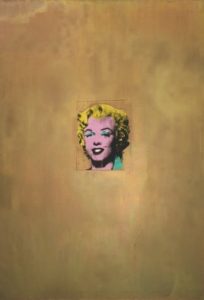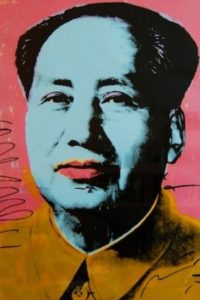How did Andy Warhol define Silk-Screening?
First, the same process is known by many names. Here are the various names that describe the process. Silk Screen. Silk Screening. Screen Printing. Serigraphy. Serigraph Printing. According to Wikipedia Silk screening is a form of Stenciling that appeared in China (960-1279AD) during the Song dynasty. Stenciling according to dictionary.com is a device for applying a pattern or design to a surface consisting of a thin sheet of cardboard, metal or other material which figures or letters have been carved out. A coloring substance is applied for passes through the “openings” or patterns and leaves those designs on whatever surface the stencil was applied too. Andy Warhol defined silk screening in the most traditional of ways. A process in which he could transfer images from magazines or newspapers to canvass.
Andy Warhol’s Step by Step Silk Screening Process
This VIDEO shows Andy Warhol silk screening the Marlon Brando you see below.

The Andy Warhol Silk Screen process itself:
- Stretch a piece of mesh over a frame (The finer the mesh the more detailed the resulting image will be)
- Lay the screen on top of your paper print
- Block off parts of the screen using a stencil (In the cases you do want elements of the image to transfer)
- Apply emulsion (Andy Warhol applied photo emulsion)
- The image will now appear on the screen or mesh
- Place the screen onto the surface you want your “reproduced” image to appear
- Apply ink. (You can see Warhol going through these last steps exactly in the provided video)
Andy Warhol would use this process on numerous materials or surfaces. Each would change the image itself. Even the Catalogue Raisonne is not certain of all of them. Here are a few examples:

Warhol used colored Lennox board for this screen print.
Lenox Museum Board – Here is lesser known Warhol example using this medium:

This Andy Warhol Screen print was made with Arches Aquarelle mold a 100% cotton material.

Rives BFK: Mold made in France, 100% Cotton, Neutral pH, smooth, watermarked
Warhol used many different mediums over the years, and there are volumes and volumes of art books dedicated to the review and commentary of his work. A few that we used as reference for this blog post are as follows:
- The Andy Warhol Catalogue Raisonne (Paintings and Sculptures 1961-1963)
- Andy Warhol – A retrospective
- Andy Warhol Prints – A Catalogue Raisonne 1962-1987
Why did Andy Warhol use Silk Screening?
Warhol’s key concept as an artist was the “industrialization” of art. Screen Printing was a process. A process in duplication. In using other people’s work and expanding upon their original concept. It wasn’t easier which Warhol would claim throughout his career. Silk Screening just matched Warhol’s sensibilities. At the time Andy Warhol was surging in popularity as a leader in the Pop Art movement some people would refer to the Screen Printing device as a machine. This corresponded to an often expressed wish of Andy’s …to be a machine. To quote Warhol directly:

“In August of 62, I started doing Silkscreens. The rubber-stamp method I’d been using to repeat images suddenly seemed too homemade. I wanted something stronger that gave more of an assembly-line effect” (Andy Warhol and Pat Hackett POPism: The Warhol 60s
When did Andy Warhol use Screen Printing?
The first popularized Andy Warhol screen print was seen in 1962. It was his Marilyn Monroe’s, and we’ve already done a chronological order to those prints. Andy Warhol would use many mediums to produce art. Video, Sculpture, Photo Engraving and much more. Warhol would use screen printing from 1962 to 1987. Here are some prime examples of screen printed work spanning that 26-year period.
- 1962 – Uses hand cut silk screens and photo silk screens to make paintings. The first example is the Marilyns.



- Campbell’s Soup Can (Tomato) 1964

- 1970-71 Creates “Flowers” (see image above) and Electric Chair

- 1973-74 Mao

- 1980 – Ten Portraits of Jews in the Twentieth Century

- 1986 – Cowboys and Indians

- Moonwalk – 1987

Where did Andy Warhol produce his Screen Prints?
Warhol used a combination of individual and corporate printers as well as his facilities throughout his career. Here is an incomplete list:
- The Factory – His studio the address of which changed a few times over the years.
- Andy Warhol Enterprises Inc. – Again his studios later in his career.
- Styria Studis Inc.
- Alexander Heinrici
- Rupert Jasen Smith
- Salvatore Silkscreen CO.
- Aetna Silkscreen Productions.
Most of these individuals and companies were located in New York. If you would like additional information such as addresses leave us a comment with an email address.





How did Warhol produce the halftones in his images? I know that now it is easy to creat such affects in photoshop.
Max – Which Warhol image are you referring to. Warhol’s production methods changed over the span of his career.
I’m not sure about Max but I would be very interested in how he produced the halftones for his death and disaster series, especially the electric chair, the photographic quality is so pleasing
Thanks, great article.
May I simply just say what a comfort to find someone who actually understands what they are talking about online.
You certainky know how to bring an issue to light and make itt important.
More people need to check this out and understand this side of your story.
I was surprised that you’re not more popular
because you most certainly have the gift.
Back in the late 1960s/early 70s my father owned a silk screen shop on Lispenard st (nyc) I used to go there as a kid it was kind of fascinating It was called the Empire Poster Service I’ve wondered if he ever crossed paths with Andy Warhol
The artist loft was there for a long time before that
Hi. What kind/brand of inks did Warhol use? Thanks.
Was Andy Warhol’s silkscreen prints considered original prints or one of a kind? How so?
Freedom,
It depends. Some of his work was one of a kind and some of it was numbered series.
I am looking at what is described as an original silkscreen printer proof, outside the numbered editions of Debbie Harry from 1980. Unsigned, unnumbered. 36 x 36. Not a Sunday B. Morning.
I am looking for more information about this piece, such as who the printer might have been, and how unusual or usual this might be.
Wonderful Scholarship and great article. Thank you!
I recently heard the term “rescreening” in connection of a Campbell Soup serigraph I was examining. In this case, it appears, that the white background of the paper support appears to have been printed over in white, presumably to hide blemishes, or discoloration.
How can I determine if the red or other portions had also been “rescreened”. It’s color over color, not color over paper which is readily distinguishable, but paint over paint is a more difficult unless a cross-section sample is taken, which is destructive.
I would appreciate your views. Thanks,
George
Hi, was Andy’s Campbell soup series hand drawn first and by whom, then silkscreened? As opposed to his screens he got from images already done by others.